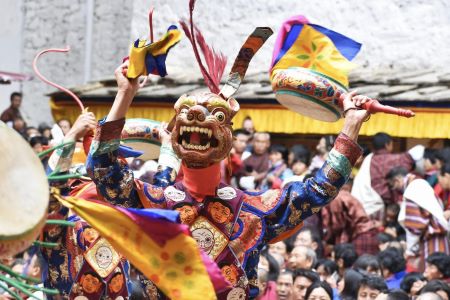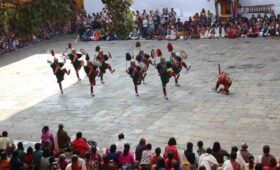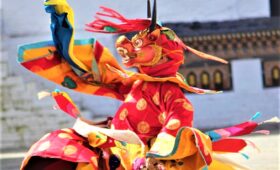The Paro Tshechu festival has been celebrated annually since the mid-17th century. It was established by Zhabdrung Ngawang Namgyal and Ponlop Rigzin Nyingpo in 1646, during the consecration of Paro Rinpung Dzong. The festival originally consisted of a weeklong drubchen ceremony and some dances. In 1686-87, the Fourth Desi Gyalse Tenzin Rabgye introduced new dances and elaborated on existing ones. The festival has been held consistently during the second lunar month of each year, as it is a time when farmers have a break from their agricultural work. Paro Tshechu Festival 2024 is held between 20 th -24th March . It is the time of the year when the valley is transformed into a breath taking panorama with peach and cherry blossoms carpeting the landscape in vibrant oink and reds.
After Paro Rinpung Dzong was destroyed by fire in 1906, Kush Dawa Penjor built a ceremonial mask dance hall on the grounds of Deyangkha so that the festivities could continue. Successive Paro Ponlops added additional elements to the program, such as folk dances.
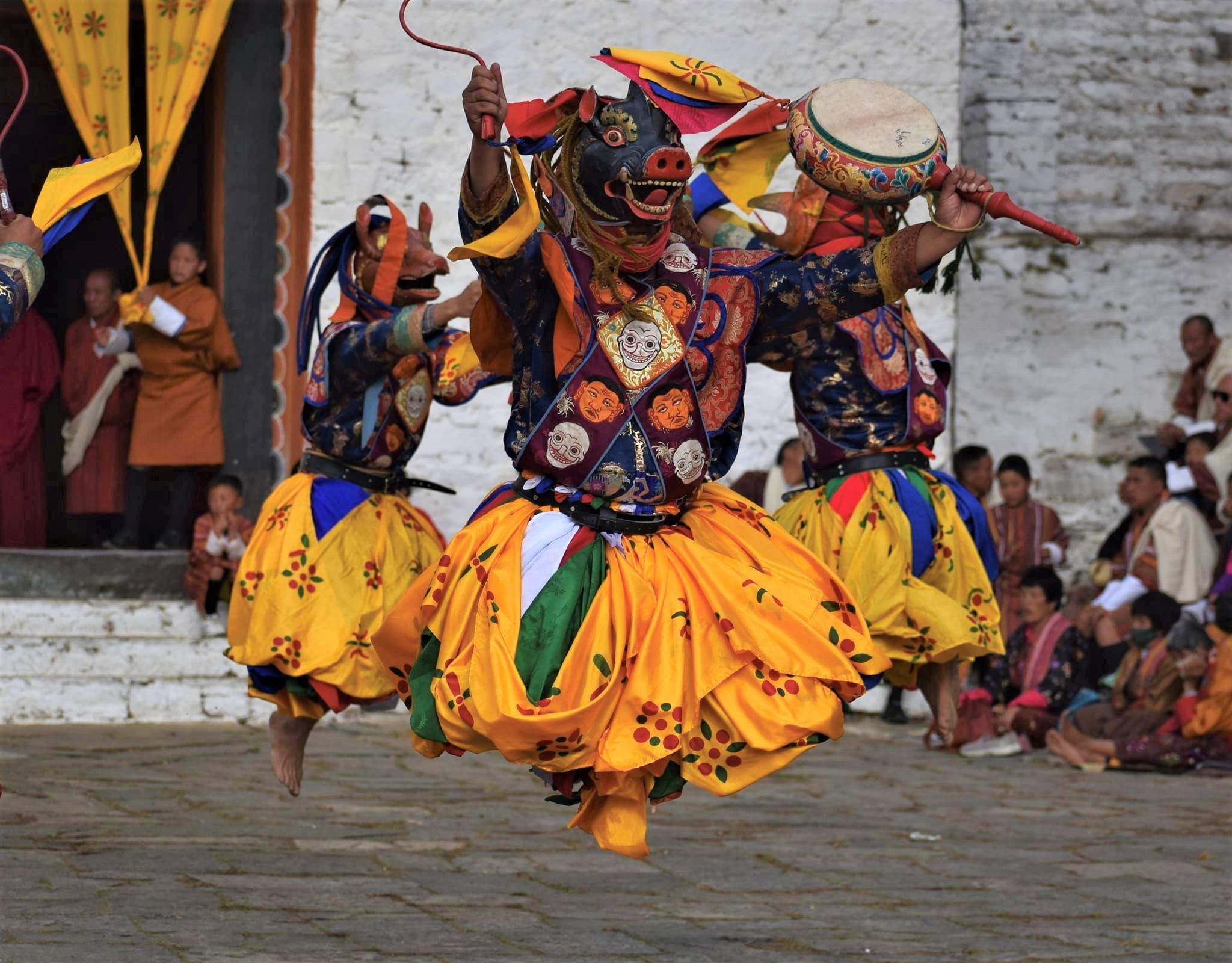
Paro Tshechu Festivity
The mask dances are a time of celebration for the locals, who are also contributing to the revival of an ancient culture whose flames have not been extinguished by the ravages of time. Not only do the locals get to relax and have fun before the start of the paddy farming cycle, but tourists and domestic visitors also get to enjoy a gala time with the colorful mask dances and vibrant folk music and dances. The residents and farmers dress to impress in elaborate, hand-woven silk ghos (for the men) and kiras (for the ladies), with the women also sporting elaborate traditional jewelry that adds yet another layer of color to the kaleidoscope of hues that bathe the joyous atmosphere.
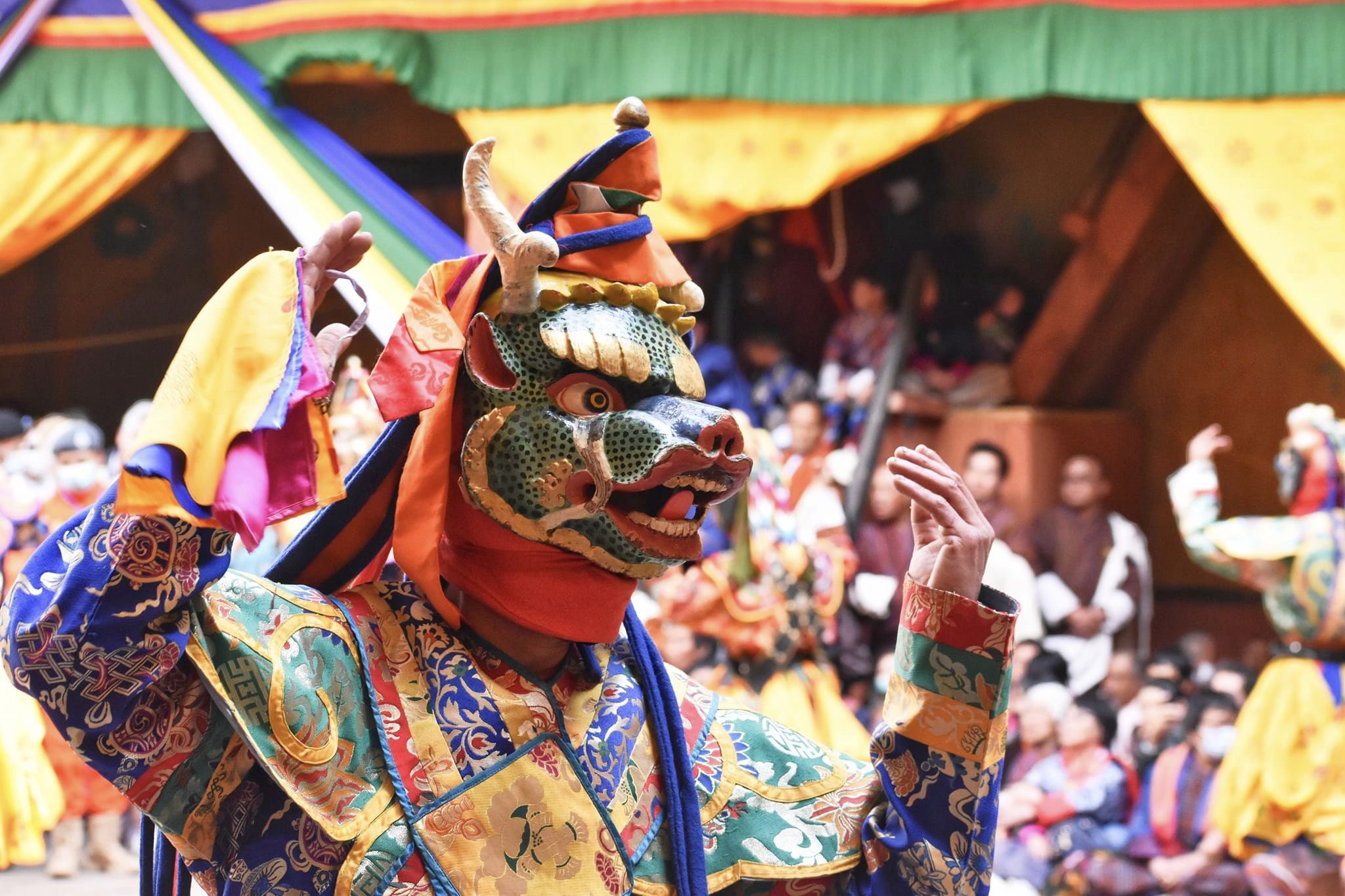
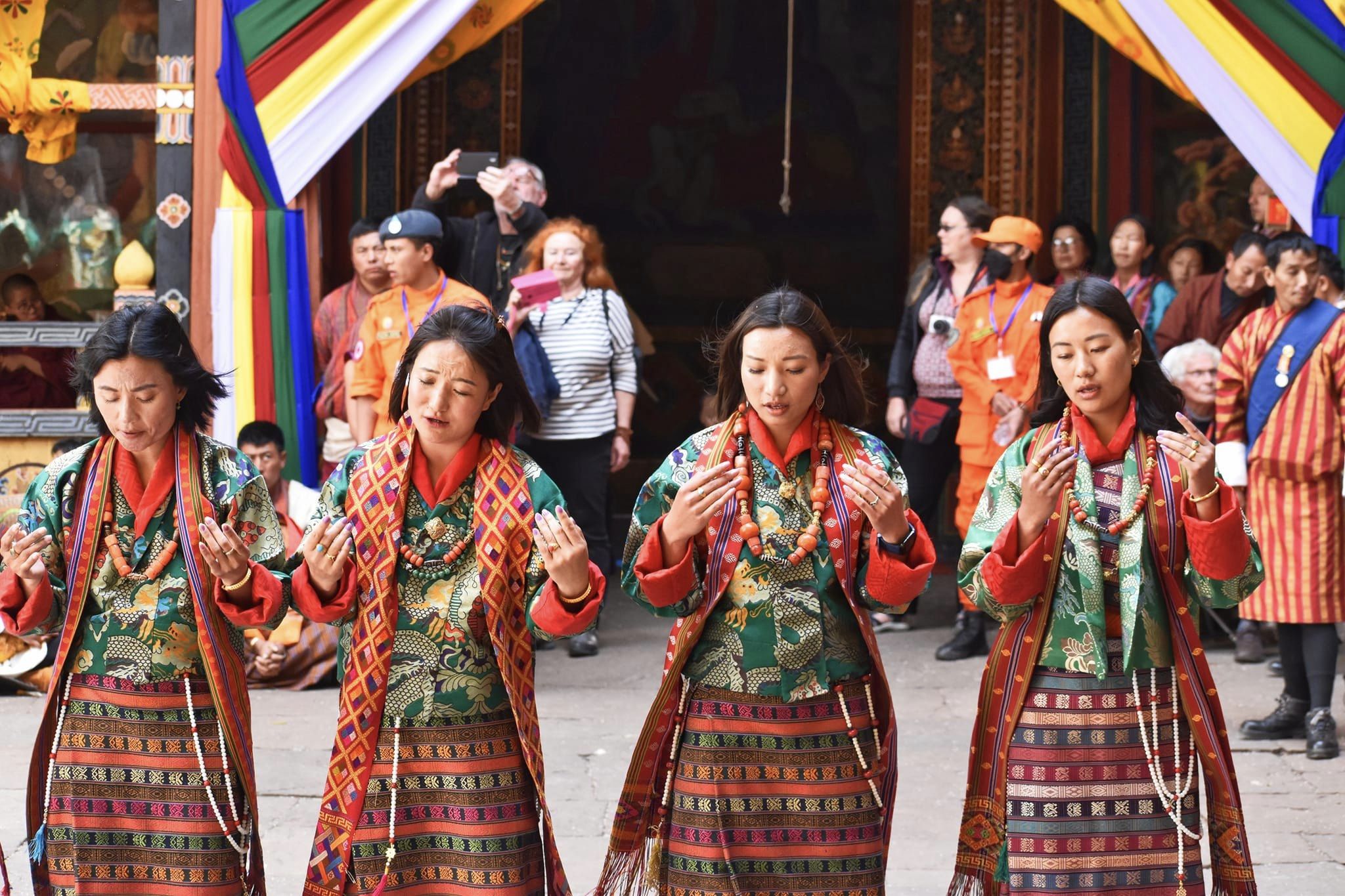
Unique elements of Paro Tshechu
Two elements that are unique to Paro Tshechu are the cymbal terma revealed by an enlightened treasure revealer (terton) in the 144 century and the second is the world’s largest embroidered thangka of Guru Padmasambhava. These objects are revealed only once in a year, during Paro Tshechu, and thus one should try their utmost to experience the blessings from these unique and important artifacts, which are considered national treasures.
Attending sacred Tshechus with pure motivation, and hearing the cymbal play can help ward off temporary obstacles, even transforming the six negative emotions into five wisdoms. Participation in Tshechus can thus make a big difference for each individual but the results are also dependant on the person’s view. A false perspective or motive can affect whether or not the potential blessings are accumulated.
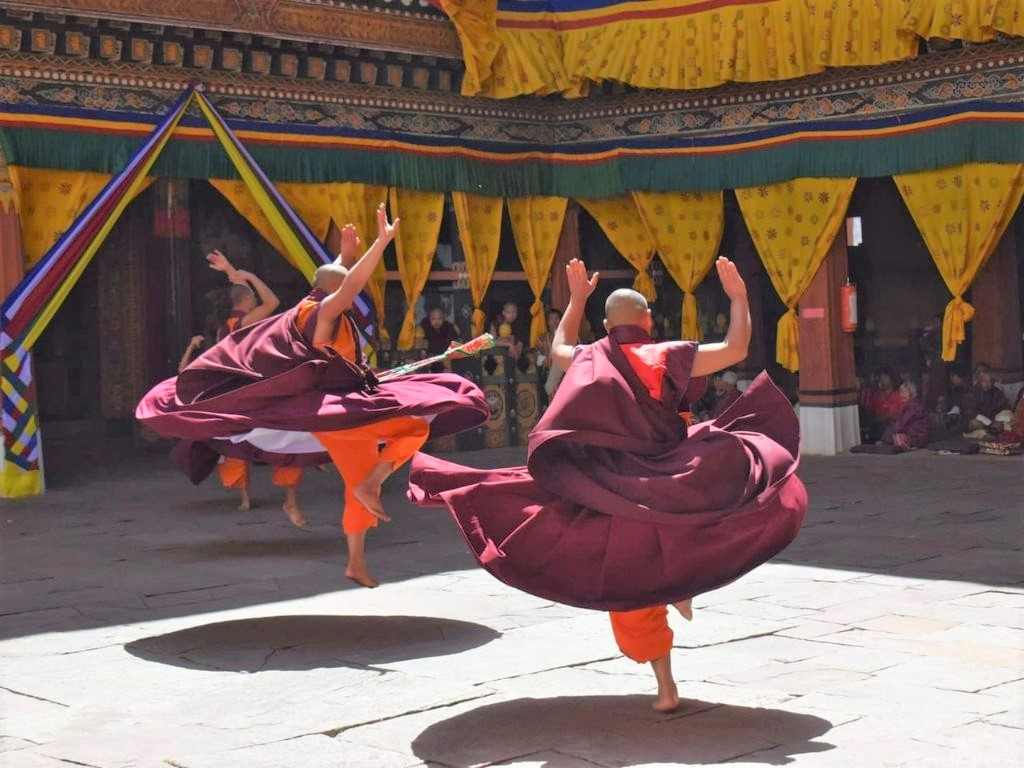
Program of Paro Tshechu Festival 2024
The Paro Tshechu is an annual five-day festival held between the 11th and 15th of the second lunar month. However, from 2008 onwards, tshechu festivals throughout Bhutan cannot exceed three days of official holiday. This means that during the Paro Tshechu, all local government institutions and offices remain closed for three days of the total five, from the 13th to 15th of the second month of the Bhutanese calendar.
The present Paro Tshechu program of events has been consistent since the 1960s when the Third King Jigme Dorje Wangchuck added folk songs and folk dances to the schedule. This fixed program repeats each year, allowing viewers to attend whatever dances or events they find most significant.
Activity
Most tsechus programs alternate folk songs with sacred dances to create a more dynamic and entertaining atmosphere. There are two types of sacred dances performed; those performed by laity and those executed by monks. The sacred dances performed by laity are called bod cham and those executed by monks are known as gelong gi cham. Both bod cham and gelong gi cham are equally sacred in terms of generating blessings through their performance and viewing, however, the costumes, masks, and sequences employed are markedly different.
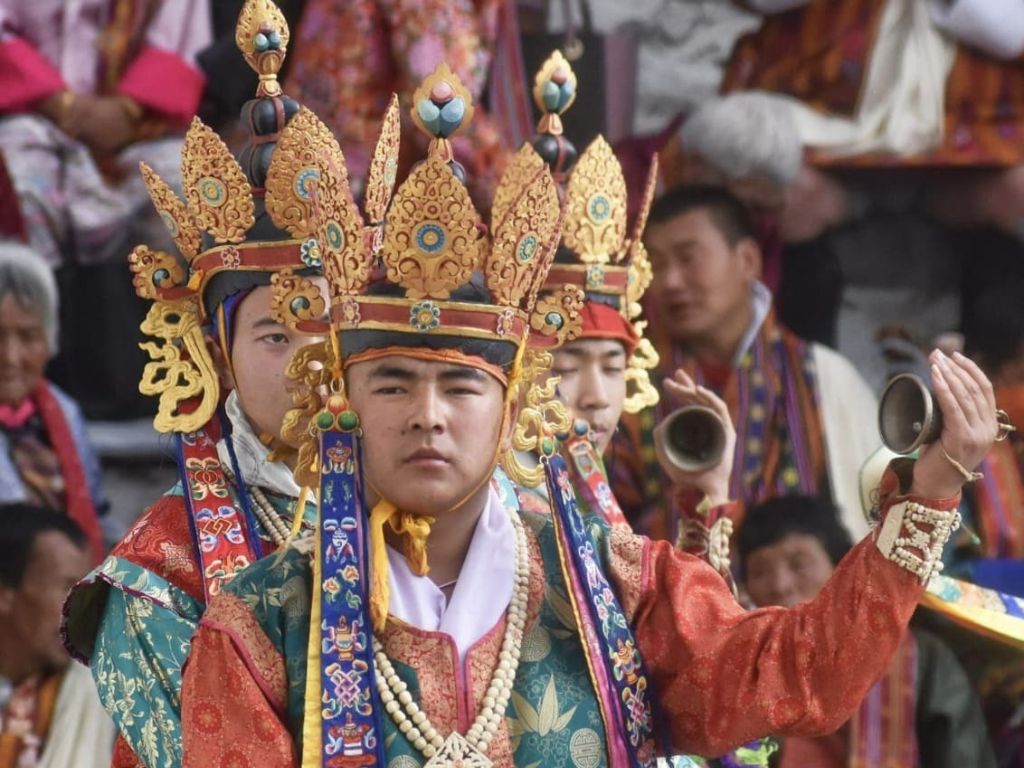
For example, the costumes used for bod cham are woven with five colors of silk, which are then tied to the belt. They extend to the knee as part of the costume’s lower apron. A silk jacket bearing the design of the double dorje is worn on the upper body. In contrast, monks presenting gelong gi cham wear phegse (or chuba type) costumes with long sleeves and bottoms that reach to the ankles. On the front of their bodies, their apron bears a wrathful face.
For some dances, the performer can be a layperson or a monastic. Such is the case with the Black Hat Dance which is usually performed by monks but due to low numbers of trained monks in some dzongkhags non-monastics have been known to exhibit it.
Experience Bhutan’s rich spiritual heritage by attending this vibrant Paro Tshechu festival 2024 during your Bhutan Cultural Tour.
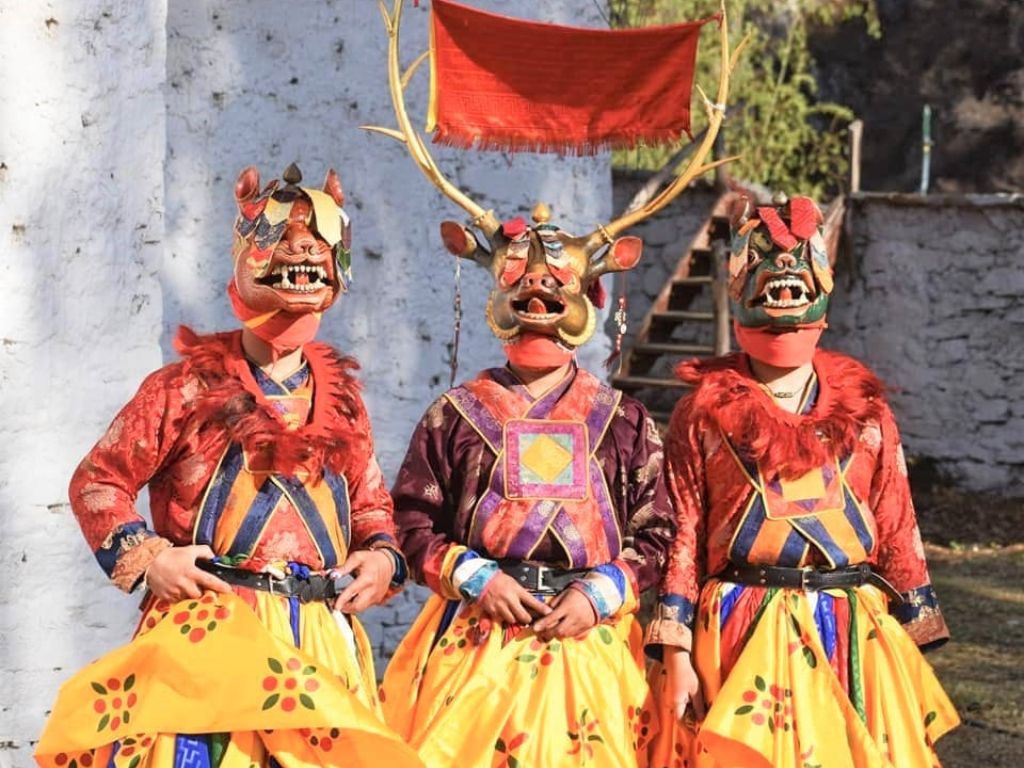
DAY ONE PROGRAMME OF PARO TSHECHU FESTIVAL 2024
On the first day of Paro Tshechu, events take place inside the courtyard of Paro Rinpung Dzong. For the duration of the festival, ceremonies are held in the open grounds of Dheyangkha, located near the dzong. The opening day begins around 9 a.m. and ends approximately at 3:30 p.m. During this day, inauguration rituals, five mask dances and eight folk songs are performed.
The regional governor, judges and public representatives line up in ceremonial procession to escort the Paro Dzong Lam Neten (head Lama) to his sitting place among other dignitaries. After being seated, the cymbal dance is performed in the courtyard led by the cymbal master. Together with many public representatives, a circle is formed as ritual instruments such as cymbals, drums and conch shells are played to invoke gods and goddesses as witnesses to the sacred events and to prevent possible obstacles.
The remainder of the day’s program proceeds as follows:
- Welcome song by dzongkhag (district) singers
- Shinje Yab-Yum (Yamantaka Yab-Yum Dance) performed by monks
- Song of Woochu Village by dzongkhag singers
- Durdag Cham (Lord of Cremation Ground Dance) performed by monks
- Zhanag Cham (Black Hat Dance) performed by monks
- Traditional song (Zhungdra) by dzongkhag singers
- Drametse Nga Cham (Drum Dance of Drametse) performed by laity
- Lunch offering ceremony by the Atsara (clown) performed by laity
- Folk song (Boedra) by dzongkhag singers
- Degyed Cham (Eight Groups of Deities Dance) performed by laity
- Song of Woochu Village by dzongkhag singers
- Song of Dranyen Chozhey by dzongkhag singers
- Folk song (Boedra) by dzongkhag singers
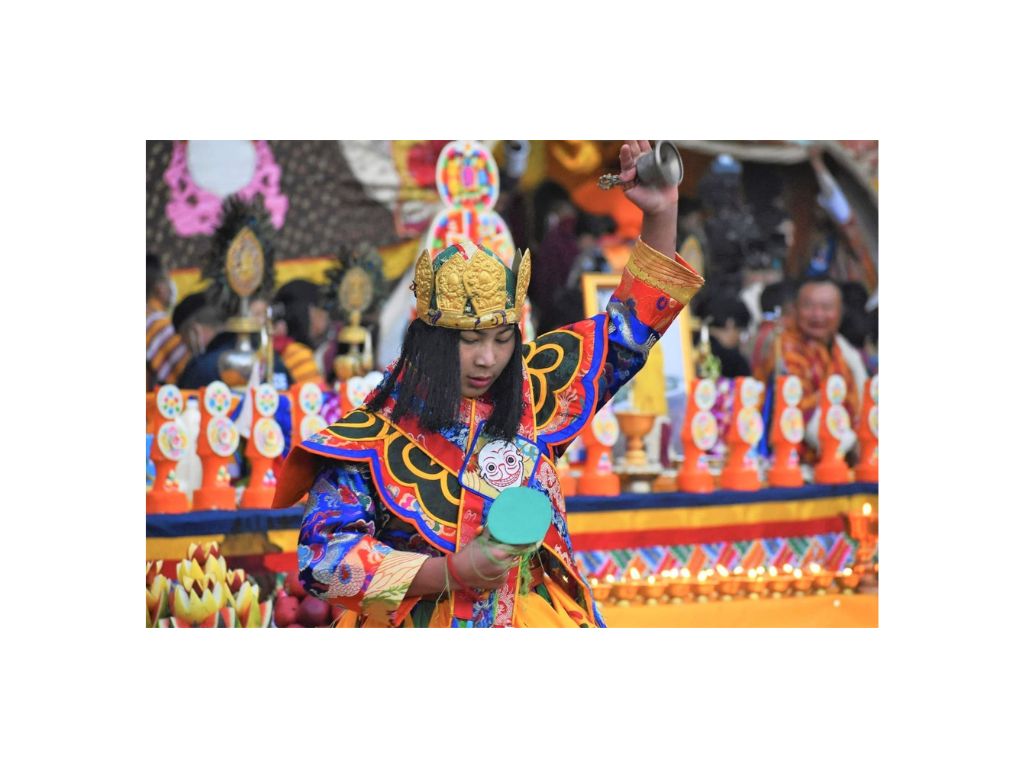
DAY TWO PROGRAMME OF PARO TSHECHU FESTIVAL 2024
On the second day of Paro Tshechu, events commence at the Dheyankha ground at 9.00 a.m. and run through the afternoon. The program consists of ten sacred dances and seven folk songs, all taking place after a chibdrel (procession) ceremony for the Lam Neten and accompanying monks. Chibdrel ceremonies honor the chief guest and monks and take place daily for the duration of the tshechu.
The program for the second day is as follows:
- Jipai Pawo Dance, performed by two males
- Cymbal Circle Dance, performed by monks
- Song from Woochu village, performed by laity
- Shinje Dance (Yamantaka Yab-Yum Dance) performed by monks
- Welcome Dance by dzongkhag singers
- Zhanag Cham (Black Hat Dance) performed by monks
- Traditional song (Zhungdra) by dzongkhag singers
- Dance of the Evil Spirit Nyulema, performed by laity
- Juging Cham (Stick Dance), performed by laity
- Folk song by dzongkhag singers
- Durdag Cham (Lord of Cremation Ground Dance) performed by laity
- Driging Cham (Sword Dance) performed by laity
- Folk song by dzongkhag singers
- Nga Ging Cham (Drum Dance) performed by laity
- Traditional song (Zhungdra) by dzongkhag singers
- Divination by clown
- Folk song by dzongkhag singers
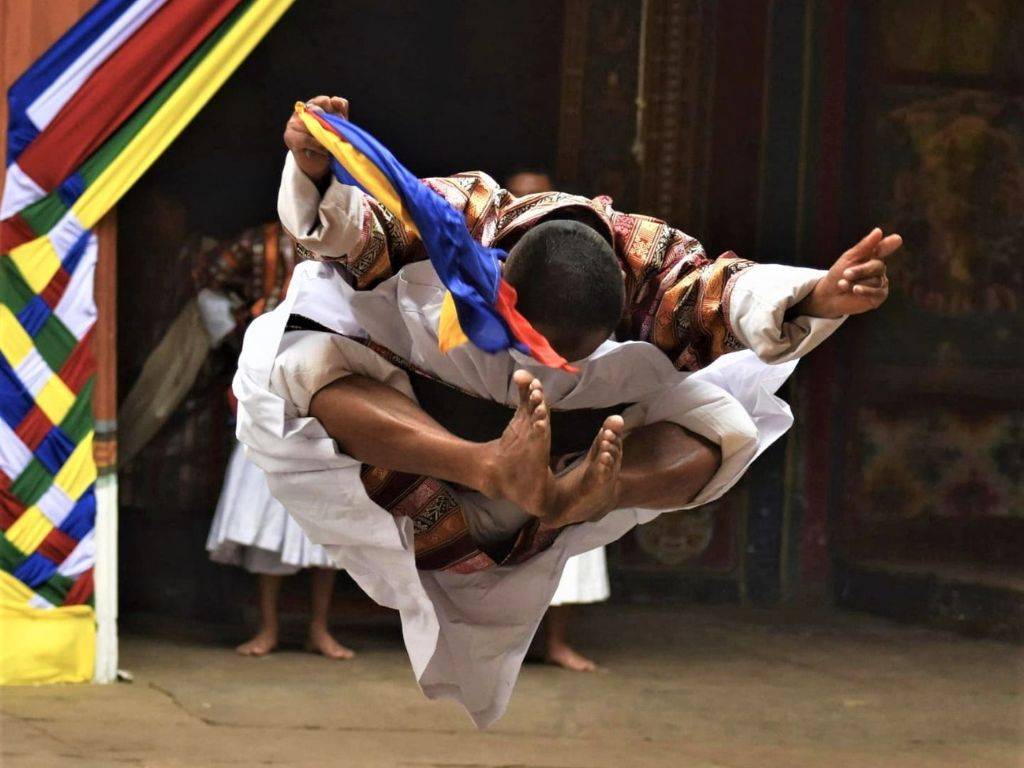
DAY THREE PROGRAMME OF PARO TSHECHU FESTIVAL 2024
On the third day of Paro Tshechu, events open with the same chibdrel procession ceremony for the Lam Neten and monks. The governor, judges and representatives gathered in the dzong proceed to Dheyangkha. The program is a bit longer, lasting from approximately 9 a.m. until 4 p.m.
There are seven sacred dances, an atsara (clown) dance and five folk songs, for a total of thirteen events for the third day.
The program for the third day is as follows:
- Folk song from Woochu village by Dzongkha singers
- Durdag Cham (Lord of Cremation Ground Dance) by monks
- Folk song by dzongkhag singers
- Tum Ngam Cham (Guru’s Wrathful Dance) performed by monks
- Gen Druk Cham (Six Ornaments Dance) performed by monks
- Traditional song (zhungdra) by dzongkhag singers
- Pholay Moley Cham (The Dance of Charming Ladies and Noblemen) performed by Laity
- Folk song of Woochu village by dzongkhag singers
- Stag and Hound dance, performed by laity
- Dance of Acho Phento and Lama Rechungpa, performed by laity
- Dance of Offering Ceremony to Mahakala, performed by Atsara
- Folk song by dzongkhag singers
DAY FOUR PROGRAMME OF PARO TSHECHU FESTIVAL 2024
On the fourth day of Paro Tshechu, the morning chibdrel procession is accompanied by a folk song of Woochu Village. Festivities end at 3 p.m. after the performance of Drum Dance from Drametse. On this day, there are five mask dances and three folk songs performed as follows:
- Folk song of Woochu village by local singers
- Shinje Yabyum Cham (Yamantaka Yab-Yum Dance) by monks
- Shazam Cham (Stag Dance) performed by laity
- Bardo Cham (Bardo Dance) performed by laity
- Atsara Go Cham (Initial Dance of Atsara) performed by laity
- Traditional song (zhungdra) by dzongkhag singers
- Folk song of Woochu village by local singers
- Drametse Nacham (Drum Dance from Drametse) by laity
DAY FIVE PROGRAMME OF PARO TSHECHU FESTIVAL 2024
On the final day of Paro Tshechu, people assemble in the pre-dawn hours to receive blessings from the Guru Thongdrol. The local representatives gather inside the main temple where the thongdrol is kept inside the main assembly hall. The monks have been up since midnight performing necessary three-hour rituals that continue until the thongdrol is moved out at 3 a.m.
The procession members shoulder the thongdrol and carry it from the tower, out of the dzong and towards the grounds. After much maneuvering and careful unrolling, the thongdrol is hung from the tower for all to see. Government representatives then return to the dzong courtyard in time to receive the Lam Neten and monks in a second procession. This is the second of three procession ceremonies that public representatives will take during this day. The third takes place when public representatives come back to the dzong and receive the Zhabdrung statue (Zhabdrung Khamsuem Zilnon) along with the ritual cake of Lama Gongdue (Gondue Torma), before taking both objects out to bless the public gathered at Dheyangkha.

Rituals
During the display of the thongdrol, the monk body conducts a series of supplication prayers to Guru Rinpoche, including a purification prayer for the thongdrol itself. This is because as the thongdrol is on display, it may become contaminated when touched by viewers who carry with them both physical and karmic contamination.
The thongdrol is generally lowered and re-rolled before sun has fully risen, spirited away before its rays can touch brocade. Applique is then returned to dzong in another grand procession ceremony where it is safely stored until next year.
The remainder of day’s program consists of ten sacred dances and four folk songs as outlined below:
- Jipai Pawo dance (Dance of Heroic Youth), performed by two lay males
- Atsara Dance of Tshoman performed by laity
- Cymbal Dance, performed by monks while Atsara imitates ‘gives birth’ to child
- Heroic Dance, performed by laity
- Traditional song by dzongkhag singers
- Tshog Ling Dance of Wrathful Deities, performed by monks
- Ging Dance, performed by laity wearing skeleton masks
- Folk song by dzongkhag singers
- Dance of Eight Manifestations of Guru Padmasambhava
- Traditional song by dzongkhag singers
- Sixteen Dakinis Dance with Hand Drum and Stick, performed by monks
- Sixteen Dakinis Dance with Damaru and Bell, performed by monks
- Dance of Chozbey (Dharma Song), performed by laity
- Song of Trashi Legpel, performed by all public representatives
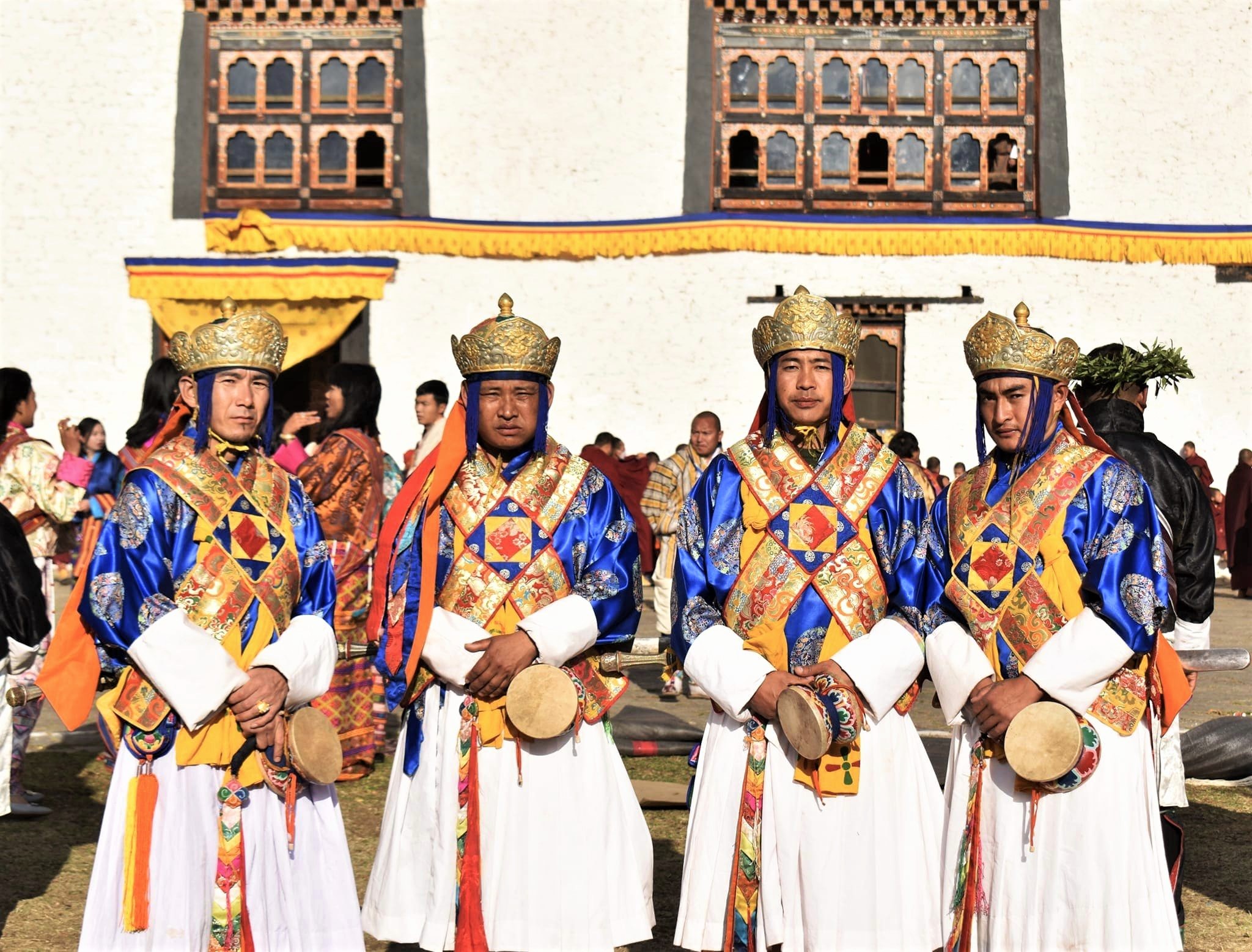
CONCLUSION
The concluding performance of Paro Tshechu, known as the auspicious wishes finale, symbolizes the formal culmination of the event. In accordance with tradition, all non-monastic individuals in attendance gather to partake in singing this special song. Led by a talented female vocalist, the entire assembly joins in during the chorus, creating a harmonious blend of voices. Even members of the royal family, if they are present, enthusiastically participate in this customary closing ritual. As a longstanding tradition, Trashi Lagpel, the closing ceremony, attracts hundreds of individuals who gradually form an expanding circle of participants. This joyful practice signifies that every gathering or celebration concludes with the auspicious song, believed to bring about happiness and prosperity for all. Anyone present can join in the dance and contribute to the collective jubilation.
So you can make your Bhutan visit complete by visiting Paro Tshechu Festival 2024
Paro Tshechu Itinerary & Tour Cost 2024
You can book the Paro Tshechu 2024 by clicking on the following link below
Paro Festival Tour Itinerary & Tour Cost
For more information on Paro Festival Tour , you can contact us
Frequently Asked Questions (FAQs)
1. What is the history and significance of the Paro Tshechu Festival?
- The Paro Tshechu Festival dates back to the mid-17th century and was established by Zhabdrung Ngawang Namgyal and Ponlop Rigzin Nyingpo. It celebrates the consecration of Paro Rinpung Dzong and features a rich cultural and religious program.
2. How long does the Paro Tshechu Festival last, and what are the key events?
- The festival lasts for five days, from the 11th to the 15th of the second lunar month. Each day is filled with a schedule of events, including sacred mask dances, folk songs, and rituals.
3. Is there a specific dress code for attendees of the festival?
- Yes, it’s recommended to wear traditional Bhutanese attire – gho for men and kira for women. This attire is not only a sign of respect for the culture but also allows attendees to fully immerse themselves in the festival experience.
4. Are there any unique elements or artifacts associated with the Paro Tshechu Festival?
- Yes, two unique elements are the cymbal terma revealed by an enlightened treasure revealer (terton) and the world’s largest embroidered thangka of Guru Padmasambhava. These are considered national treasures and are revealed only once a year during the festival.
5. Can visitors and tourists participate in the festival activities?
- Absolutely! The festival is open to both locals and visitors, providing an opportunity to experience the vibrant mask dances, folk music, and cultural celebrations. It’s a great way to witness and be a part of Bhutan’s rich spiritual heritage.

